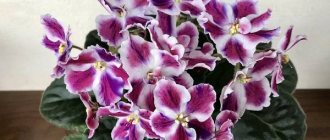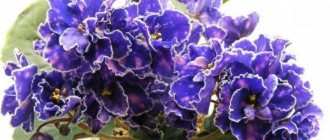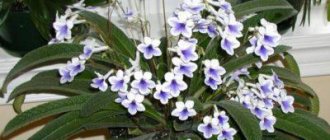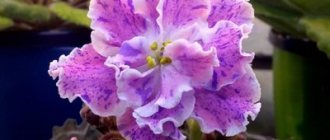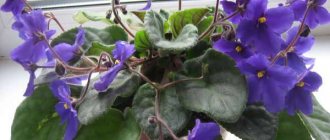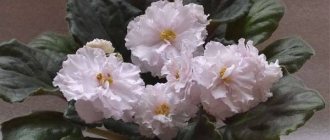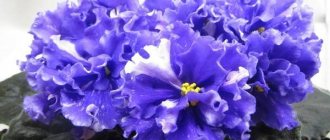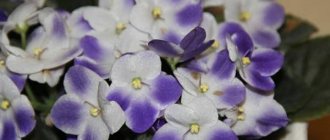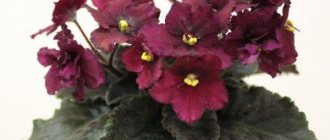Dazzling violets with uniquely beautiful and large flowers in magical shades of the color palette:
- They are a summary of the long and painstaking breeding work of the Kursk violet breeder Natalya Skornyakova;
- And they stand out among other domestic varieties by the presence of the abbreviation “RM” in the name.
In the article you will learn what the varieties of violets of the Republic of Moldova look like: Steppe Young Lady, Cynthia, Nadezhda, Lydia, Taisiya, Sister Alyonushka.
Violet RM-Steppe Young Lady
A standard fantasy variety with elegant shades of pink palette was presented to flower growers in 2017.
Cute violet Steppe Young Lady.
Image of decorative touches
The violet manifests itself as a plant:
- Does not require constant care from a grower;
- She shows her independence;
- By independently assembling a fairly neat rosette and transforming it, using the principles of tiled alternation of elements adopted in architecture, into an adult bush with a clear symmetry of volumetric and spatial configuration and dense filling with leaves.
The tiled design of the outlet allows each segment to use the same amount of solar energy.
Medium-sized violet leaves differ:
- Wide - oval in shape with very small ones;
- Almost smoothed teeth;
- Smooth, glossy surface;
- Symmetrically - with a depressed venation pattern;
- Smooth contour of the side edges;
- And rich shades of spring foliage.
Flowers by type belong to the “star” category, which has:
- Large dimensions;
- And terry or semi-double fullness structure.
a large segmented fringe decorating the violet .
NOTABLE! The color scheme of the corollas consists of a chaotic mixture of shades of lilac and raspberry with a slight addition of coral notes. The intensity of the colors intensifies in the center and weakens to a white stripe - towards the edges. The entire surface of the flower is thickly splattered with dark fantasy specks of raspberry color, which almost merge into a ribbon on the contour.
Sports
The seedling has not yet been noticed in sports education.
Peculiarity of development in room collections
This violet:
- Doesn’t get capricious during care procedures;
- Shows independence when creating an outlet;
- Feels comfortable in a room microclimate.
This variety grows and develops well at home.
Featured variety:
- It has spectacularly decorated flowering;
- Forms huge volumes of flower caps;
- And it is able to delight flower growers for a long time with the presentable freshness of the corollas.
With an increased temperature gradient in varietal violet flowers, fancy specks may swim until large spots form along the contour.
Reviews
Anna Antonovna. “ The violet “Steppe Young Lady” has a completely unique flower color. Several shades are mixed so harmoniously into a large mix that it is impossible to tear yourself away from its contemplation.”
Reproduction of the variety
Violet Svetlana: photo of the variety
There are two ways to propagate Svetlana violets - cuttings and stepsoning.
- Cuttings
The time for the procedure is spring. From the flower you need to take a stem that is neither young nor old, but so that it is neat and not damaged. More often I use green-colored leaves, because variegated leaves are not so suitable.
The leaf is cut to the middle and placed in a container with water one centimeter deep. As soon as small roots of ten to fifteen millimeters in size appear, it is planted in a container with soil made of sand and peat, as well as with the addition of vermiculite.
Next, the leaf is covered with film, this way it retains moisture better. Also, do not push the cutting too deeply, because the seedlings will need to be given force to stretch towards the light.
The first sprouts to appear may take one and a half to two months. They have a white or cream color. Without parents, such seedlings will die. The main thing is that there are leaves on the shoots.
Therefore, the cuttings are fed with urea. Light is also important, constant and bright, so place the seedlings to the east and west of the house.
They can be replanted only when leaves of forty to fifty millimeters in size appear on the shoots. The soil for replanting should not be dense.
- Stepsoning
Stepchildren can be seen on the lower side of the leaves; they are used as shoots. A rosette from such a stepson can develop from thirty to forty days. Only from eight to nine months the plant begins to bloom.
It is better to do pinching while replanting the plant. You also need to plant the stepchildren separately from the rosette of the mother bush. If this is not done, then several plants will appear in one container, and in this case flowering is impossible.
Stepchildren are done extremely carefully, then the stepsons are transplanted into soil with sand, peat and always vermiculite for loosening and development of the root system. With a growth of thirty to forty millimeters, rosettes can develop independently.
Violet RM-Cynthia
Delicate Saintpaulia Cynthia.
The touching white standard with pinkish shades and transitions began to be found in collections since 2016.
Demonstration of specific traits
Violet is a very disciplined plant:
- She herself tightly arranges mosaic patterns of leaves in tiers;
- It itself ultimately forms a magnificent, almost flat rosette, distinguished by: Compact structure configuration;
- And neat symmetry of the edge.
Bushes of this variety, as in the implementation of architectural projects, from the outside look like a clear graphic picture due to the alternation of all elements - leaves - in a mosaic technique.
The leaves are broadly oval in shape with a noticeably pointed tip and have:
- Large sizes;
- Active waviness of the configuration of the side edges;
- Clearly extruded venation graphics;
- Emphasized by a salad tone color;
- Quilted surface;
- Large - wavy, but neatly cut edge teeth;
- And the general tonality in the colors of lush summer foliage.
ATTENTION! The violet bush blooms with huge corollas of simple filling, having a “star” type texture and painted with a white color, which is noticeable only at the stage of bud opening. On the main background of the petals, shades of pink prints are very densely intertwined, onto which the lemon tone of the core is sprayed in the center of the corolla. This forms a spot of bright tonality in the center. A thin pink edging ribbon is visible along the edge of the petals. Each of the “star” petals visually forms a ray narrowed in the middle, ending in an expansion with a fringe.
The variety has large, wavy flowers.
Sports
Violet is characterized by the stability of varietal categories; it does not form sports.
Unique development in the room
Saintpaulia represents a group of varietal varieties that:
- React positively to classically simple methods of care;
- And they are very unpretentious in terms of their content.
Violet is distinguished by a lot of positive qualities:
- It itself builds a compact and dense structure of the bush;
- It has a huge number of buds on each peduncle;
- Gives leaf babies a color similar to a chimera;
- Supports long flower life.
Saintpaulia blooms very luxuriantly.
Reviews
Genrikh Ilyich. “ The variety “Cynthia” amazes with its excellent quality. Everything about it is almost perfect. But the most mysterious thing: the color of the flowers is close to the texture of chimeras, and the violet easily transmits this characteristic through leaf children, which is not possible with chimeras.”
Transfer rules
Violet Svetlana needs low-nutrient soil - this is a feature of the variety.
The soil for replanting the indoor violet Svetlana should be low in nitrogen, that is, low in nutrition. By planting a violet in a substrate rich in organic matter, you can get a plant with completely green leaves.
The main component of the substrate for transplantation is coniferous soil (5 parts). 3 parts of peat and 1 part of coarse river sand are added to it. An additional loosening component is vermiculite (10% of the total volume of the mixture).
Pots for transplanting are used with a small diameter: 5-6 centimeters for children, 7-8 centimeters for young rosettes, 9-12 centimeters for adults. Drainage is placed at the bottom of the pot, with a height of 3 to 5 centimeters.
Young rosettes are replanted while preserving the earthen ball, placing them in a pot of larger diameter and sprinkling the remaining space with the prepared substrate. Adult plants are replanted, freed from old soil. You can water the transplanted violet only after a day.
Violet RM-Nadezhda
The most delicate pink Saintpaulia of the standard type has been appearing at exhibitions since 2014. The beautiful violet RM-Nadezhda, a photo of which you can see below, develops well at home.
Sweet violet Nadezhda.
Presentation of special touches of the variety
The violet, starting to develop from the baby, independently, very symmetrically and at the same time in a neat order, arranges the growing leaves on a small number of floors - tiers that can create its decorative appeal .
The resulting adult bush of a compact configuration reveals, as in an architectural project, a magnificent pattern of mosaic alternation of leaves , where each section is sufficiently open and thanks to this can receive the optimal amount of solar energy.
Medium-sized, oval-structured violet leaves have:
- Barely noticeable, smoothly shaped tip;
- Wonderful - dense structure;
- Sharply jagged teeth along the contour with a barely visible wave-like texture;
- Fairly smooth texture of the quilted surface;
- And the coloring of the juicy green tones of summer foliage.
The violet forms majestic caps from huge corollas of the “star” subspecies , densely filled with petals to the terry degree of the type. The coloring of the corollas includes smooth flows of shades of pastel pink:
- From light peach on the edges of the petals;
- To intense pink, almost crimson - at the very core of the flower.
With slight decreases in thermometer readings, the edge of the lower petals turns slightly greenish . The petals themselves are different:
- Quite dense texture;
- And slight structural elongation.
Flower petals have a dense texture.
Sports
Violet does not bloom very often , forming absolute textured copies of varietal flowers, but only in the purest white color. Sports Saintpaulia:
- Showed perfect repetition of her traits in her offspring;
- And it was registered as the variety “RM-White Gardenia”.
White sport Saintpaulia.
Difficulty of cultivation in collections
The variety is quite pleasant in cultivation:
- It creates a dense, obedient rosette;
- Likes to bloom early and bud often;
- Constantly increases the size of flower caps.
CAREFULLY! In a cool microclimate, a violet can add greenish notes to the pink palette of the lower petals - if there is no desire to change its decorative appearance, then you should carefully monitor the thermometer readings.
The flowers of the variety are large and lush.
Reviews
Julia. “ Violet “Nadezhda” for me is very similar to small peonies with its pom-pom flowers, and its magnificent sport “White Gardenia” brings me into a state of quiet delight.”
Diseases and pests
Various pests and diseases cause pain to violets:
- Whiteflies;
- Cyclamen mites;
- Thrips;
- Mealybugs;
- Root-knot nematodes;
- Gray rot;
- Powdery mildew;
- Fungus gnats;
- Vascular bacteriosis.
The reasons that contribute to the emergence and spread of diseases are simple:
- The presence of dust on the leaves;
- Mistakes when watering violets;
- Lack of light;
- Poor ventilation;
- Soil infested with pests;
- Low room temperature, below 14 °C;
- Too much air humidity;
- Hot weather.
prevention measures :
- Plants should be watered properly;
- Use quality soil;
Burn on violet leaves. - Ensure good ventilation in the room;
- Do not allow the temperature to drop below 14 °C;
- During hot weather, move plants away from windows.
Violet RM-Lydia
A bright, memorable variety of standard form was introduced in 2016 .
Enchanting violet Lydia.
Description of decorative features
Violet, differing:
- Independence is useful in violet growing;
- Without the help of a florist, it is able to collect leaf plates that form as it grows into dense textures;
- And carefully place them on the “floors” of the plant’s volume.
In this way, a beautiful rosette with a characteristic symmetrical configuration is gradually obtained .
Leaves of medium-sized diameters have:
- Classic oval shape with a slightly pointed tip;
- Quilted surface with a matte texture and lots of silver fibers;
- Small, rounded teeth filling the edge with wavy curves;
- And an inconspicuous pattern of venation, which has a central axis of symmetry in the form of an enlarged main vein of a light green color.
The leaves are colored in the dark shades of summer foliage , and their reverse side acquires a burgundy coating with age.
Violet corollas:
- Represented by large “stars” of semi-double and less often – simple degree of filling with petals;
- Painted in an even shade of pink shades of varying color intensities with subtle coral notes;
- And they have a wavy texture of the petals with a sparse fringed edge frame.
The color intensity of the petals intensifies towards the center , where it can acquire a deep red tone.
The variety has large flowers.
Sports
Violet is not noticed in sporting activities.
Non-standard contents in the room
Saintpaulia:
- Does not differ in whims when leaving;
- Adapts to the microclimate of home collections quite easily;
- And shows independence at the moments of bush formation;
- Has a charming decorative appearance when flowering;
- Blooms in voluminous caps;
- And its corollas are able to maintain a presentable appearance and fresh texture for a long time.
Varietal violet is good for indoor cultivation, as it has a bouquet of such positive qualities as:
- Symmetrical and compact outline of the bush;
- Development without obvious problems with minimal care;
- An abundance of buds, the dissolution of which gives voluminous caps.
ADVICE! The variety is favorable for cultivation by beginning flower growers in their emerging collections.
Reviews
Milana Andreevna. “ I realized that N. Skornyakova’s varieties, with rare exceptions, are distinguished by their simplicity in cultivation, independent “assembly” of rosettes and marvelous formats. Violet "Lydia" was no exception. I recommend it to everyone and - thanks to the master for the variety!”
Care techniques in the home microclimate
In the microclimate of indoor collections, the violet is distinguished by its very unpretentious behavior - the plant responds to the regular and careful implementation of agrotechnical practices typical for the genus by harmonious, measured development and the formation of luxurious bouquets of flowering:
- the plant likes to grow on windows facing west or east , where a suitable balance of volume and light intensity is maintained: windows in the north direction should be equipped with an additional illumination system with diffuse spectrum rays;
- on southern windowsills, violets will need a light curtain in the summer heat.
- watering - dosed. Strict control over the condition of the upper part of the substrate is required - at each stage of watering, the soil in it must have time to dry out;
- to apply mineral fertilizing too often - the violet itself can indicate the need for this procedure with its appearance;
- proper lighting makes it possible for the harmonious development of violets - the tropical beauty needs diffused rays of daylight when exposed to them for a sufficiently long time;
- the temperature gradient should be maintained at +20 + 24°C. Do not expose the violet to sudden changes in temperature and drafts;
- when creating comfort, it is necessary to provide the violet with rich nutrition through fresh, aerated and permeable soil with sufficiently reliable drainage;
- At the time of transplantation, it is better to use the transshipment technique - it is less painful for the violet. But this method is not suitable if it is necessary to completely examine the roots of a diseased plant.
Violet RM-Taisia
A spectacular standard Saintpaulia with expressive prints was produced in 2013.
Unusual violet Taisiya.
Designation of decorative features
Violet RM-Taisia, a photo of which can be seen below, purposefully folds young leaves into:
- Ideal in configuration;
- And a dense rosette to fill the tiers.
Compact bushes with a neat structure rarely violate the boundaries of the typological dimensions of their subspecies.
The leaves are different:
- Small dimensions;
- Depressed venation graphics;
- The rich tonality of summer foliage;
- Smooth surface with shiny texture;
- And large, pointed teeth.
The contours of the leaves have some wavy edges.
The flowers are characterized by a large diameter , their format is “star” with a simple or semi-double filling of the volume with petals of a wavy texture. The edges of all petals are decorated with frequent and large-sized fringe.
The tonality of the corollas is expressed by a combination of the main white color with intense crimson prints , filling almost the entire surface of the flower, except for the white eye in the center and a thin braid along the edge.
ATTENTION! The effect is enhanced by the velvety texture of the petals.
The variety has bright crimson flowers.
Sports
The plant is seen infrequently sported. In sports crowns, the color of the prints floats over the entire surface.
When sport appears, violet flowers darken.
The originality of growing at home
Violet is not at all picky , but there are still some nuances in the process of its life. The variety develops steadily, blooms together, with many buds, and gradually increases the volume of the cap. From the first flowering, the violet has strong, durable flower stalks.
Flower growers need to carefully monitor the microclimate in their home collections, especially the temperature regime :
- With the proper temperature gradient, the corollas are colored as effectively as possible;
- In too hot conditions, the color fades and the corolla loses its characteristic star pattern in the center.
When the air temperature changes, the flowers change their color.
Reviews
Yan Filippovich. “ At exhibitions I always paid attention to orth , but I didn’t take the leaves - I thought that I couldn’t handle the prints and the violet would “float.” But still I couldn’t resist, now I have a gorgeous Taechka growing up - she doesn’t act up, she develops on her own and very harmoniously. I’m waiting for the first flowering, I hope it will be successful.”
Buying tips
The varieties selected by Tatyana Pugacheva are standard, bouquet flowering , stand out for the size of the flowers, incredibly huge in size, covered with delicate hairs. At exhibitions, collectors will recognize the varieties presented by Tatyana Pugacheva. The pink color of flowers predominates in the breeder's catalogs.
But when choosing a flower, you need to focus on the following indicators indicating the health of the flower:
- leaves are juicy, fleshy, bright green;
- There should be no defects on the leaves.
A healthy violet should have fleshy leaves without blemishes.
If you purchased a blooming Saintpaulia , you need to provide for the conditions for its transportation. The plant experiences stress when leaving its usual place, so it can drop its flowers ahead of schedule. A violet with unopened flowers tolerates movement more easily and, once in bloom, will bloom for a long time.
Violet RM-Sister Alyonushka
A marvelous variety of white varieties has represented the standards since 2015.
Angelic violet Sister Alyonushka.
Image of decorative features
Violets of optimal dimensions from the first day carefully and independently lay out leaf plates within the boundaries of the even contours of the rosettes , adhering to the principle of tiled laying accepted in architecture.
As a result, mature bushes of a compact configuration appear with a clearly calculated symmetry of the leaf pattern.
The oval texture of violet leaves with a noticeably pointed tip differs:
- Quilted surface with a fleecy texture;
- Clear graphics of pressed veins;
- Coarsely cut teeth along a wavy edge;
- And the bright colors of summer foliage.
The violet is especially valued due to the regal texture of the white flowers with a pinkish glow emanating from the center: the corollas are huge in size and the number of their petals corresponds to the dense version of the terry type and, due to the strong fringe of the petals, form lush, airy pompoms.
Sports
Violet is characterized by a lack of sports activity.
Sports are not found in this variety.
Specifics of room keeping
Violet blooms in large volumes and for a long time - unlike many varieties with white flowers, Saintpaulia corollas can remain fresh for quite a long time. The size of the flowers and their number surprise you from the first wave of budding.
IMPORTANT! Lush caps stand upright due to the efforts of strong but short peduncles.
The variety produces large white flowers.
Reviews
Vera Sergeevna. “I added the violet “Sister Alyonushka” to the collection - I’m not particularly fond of white varieties, but this violet “caught me” with its huge balls of flowers and pink radiance from the center. Now I recommend this variety to all my friends.”
Transformation magic
The extraordinary variety was the result of the painstaking work of breeder Konstantin Lvovich Morev. Violet became known to flower growers in 2007.
Species affiliation
Forming a medium-diameter rosette, the violet Magic of Transformation (Morev) is classified according to the standard type . By the number of petals in the corollas, the violet belongs to the terry type, and by color - to the border type.
Description
Representatives of the variety form an even rosette with a symmetrical contour from small leaf plates decorated with soft wavy edges. The leaves are a dense shade of dark green with a brownish-reddish tint.
The Saintpaulia variety blooms according to the bouquet type . On strong peduncles there are medium-sized, but very double flowers.
The wavy petals of the corolla are distinguished by a thickened structure, which makes it possible to withstand natural adversities and preserve the freshness of the flowers for a long time.
The color of the buds is quite characteristic: from soft pink to violet with a thin greenish-yellow stripe along the edge.
Features of growth and flowering
The unusual ability of the flowers of the Magic of Transformation can be called a feature of the variety: throughout the long flowering, each corolla changes the tone of its color.
The bud blooms with a delicate pink color, reaching a white tone in particularly hot conditions. Gradually the intensity of pink increases, sometimes the flowers may have black areas.
The rim around the edge of the petal also becomes brighter towards the end of the flowering period.
Another feature is the full opening of the buds , which is very difficult due to the tight structure of the petal tissue. The process of opening the corolla takes up to 20 days, but they bloom for a long time.
Nuances of maintenance and care
Due to the specific characteristics of the variety, caring for violets involves protecting them from high temperatures during flowering in order to maintain the brightness and contrast of color. The decorative effect of Saintpaulia will decrease if the color scheme of the buds is reduced to a white tone.
Reviews
Ellina. “The name of the violet very correctly reflects its ability to change color throughout its flowering period. For a long time you can really observe the Magic of transformation from a light bud into a purple corolla.”
Yana. “I really like violet flowers. The magic of transformation at the white scale stage. But I understand that high temperatures are harmful to the plant, which provoke the loss of bright color. Therefore, I protect my violet from the heat by all means.”
Useful video
Watch the video on how to care for violets at home: Find out in the video how to properly replant Saintpaulia: Interesting facts on the video on how to rejuvenate violets: Watch the video why violet leaves wither:
Distinctive features of varieties selected by Boris Mikhailovich and Tatyana Makuni
Flower growers note the neatness and compactness of the rosettes in the varieties of Makuni breeders. Also, everyone agrees that when propagated by cuttings, varieties convey varietal characteristics well, there are almost no sports, and the flowers on the same plant are similar to each other, like twins. All these are signs of high-quality breeding work.
The downside is that the plant needs to be regularly rejuvenated, otherwise after 3-4 flowerings its decorative effect begins to wane.
From separate articles on our portal you can learn about violets that were bred by equally talented breeders such as Konstantin Morev, Alexey Tarasov, Natalya Puminova, Tatyana Dadoyan, Svetlana Repkina, Tatyana Pugacheva, Evgeny Arkhipov, Elena Korshunova, Elena Lebetskaya and Natalya Skornyakov.
Boris Mikhailovich and Tatyana Nikolaevna Makuni are at the origins of the domestic selective breeding of Saintpaulia. They started their work when a simple pink or double violet was a novelty, not to mention two-tone or fancy colors. Breeders have done a lot of work, including popularizing Saintpaulias in the vast expanses of the former USSR.
White varieties
Most flowers, which are called nocturnal, can be white. Some of them were bred by breeders, others are naturally white varieties.
White night violet is most often:
- Lyubka bifolia;
- Lyubka Far Eastern;
- mathiols of all types;
- Siberian noctule.
These beautiful gardens can be a beautiful part of the garden and their white color looks even more beautiful at night.
Is it possible to achieve cap flowering?
The very first flowering is usually not a cap; the young rosette produces only a few peduncles , on which several flowers are located.
Violet has cap flowering.
But an adult specimen, when it has gained the required amount of green mass, with good care, in the second flowering already pleases with a dense cap of snow-white flowers .
